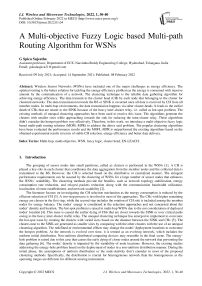A Multi-objective Fuzzy Logic based Multi-path Routing Algorithm for WSNs
Автор: G. Spica Sujeetha
Журнал: International Journal of Wireless and Microwave Technologies @ijwmt
Статья в выпуске: 1 Vol.12, 2022 года.
Бесплатный доступ
Wireless Sensor Networks (WSNs) have included one of the major challenges as energy efficiency. The optimal routing is the better solution for tackling the energy-efficiency problem as the energy is consumed with massive amount by the communication of a network. The clustering technique is the reliable data gathering algorithm for achieving energy-efficiency. The data transmit to the cluster head (CH) by each node that belonging to the cluster for clustered networks. The data transmission towards the BS or SINK is occurred once all data is received by CH from all member nodes. In multi-hop environments, the data transmission happens via other cluster-heads. It leads to the earlier death of CHs that are nearer to the SINK because of the heavy inter-cluster relay, i.e. called as hot-spot problem. The existing methods of unequal clustering approaches have been used to resolve this issue. The algorithms generate the clusters with smaller sizes while approaching towards the sink for reducing the intra-cluster relay. These algorithms didn’t consider the hotspot problem very effectively. Therefore, in this work, we introduce a multi-objective fuzzy logic based multi-path routing solution (MOFL-MPR) to address the above said problem. The popular clustering algorithms have been evaluated the performance results and the MOFL-MPR is outperformed the existing algorithms based on the obtained experimental results in terms of stable CH selection, energy efficiency and better data delivery.
Multi-hop, multi-objective, WSN, fuzzy logic, cluster head, EN-LEACH
Короткий адрес: https://sciup.org/15018384
IDR: 15018384 | DOI: 10.5815/ijwmt.2022.01.04
Текст научной статьи A Multi-objective Fuzzy Logic based Multi-path Routing Algorithm for WSNs
Published Online February 2022 in MECS DOI: 10.5815/ijwmt.2022.01.04
The grouping of sensor nodes into small partitions, called as clusters is performed in the WSNs [1]. A CH is played a key role in each cluster that coordinates the data aggregation from the member nodes and the collected data is transmitted to the BS. However, the CH is selected based on the distributive or centralized manner. The stringent performance requirements can be assured by the clustering of WSNs for a large number of sensor nodes that enhances the WSNs’ scalability. The clustering methods provide the benefits, such as network topology stabilization, energy consumption rate reduction, and relayed packets reduction along with the communication bandwidth utilization, localization of route establishment, and network scalability [2].
The literature focuses on investigating the CH selection mechanism as the energy consumption is reduced by the efficient selection of CH [3]. A two-step process is involved in most of the approaches. The CHs with higher remaining energy are chosen in the first step, while the second step includes the rotation of CH role is included among the member nodes for energy balance. The nodes’ energy is considered in the selection approaches and not concerned about the nodes’ density and location. The hot-spot problem is raised in multi-hop WSNs due to the not consideration of deployed nodes’ location [4]. This issue is caused the earlier dying of CHs that are closer towards the SINK or over critical paths owing to the heavy inter-cluster traffic relay. The unequal clustering technique has emerged to implement to overcome the hot-spot issue by creating the clusters with varied sizes based on the distance between the SINK and CHs [5]. The clusters near to the SINK are generated as smaller sizes by comparing with the other clusters with the use of an unequal clustering algorithm. The redefined or environmental effects may change the nodes’ deployment locations to overcome the hotspot problem. As the network is evolved over time, it is termed as an evolving network, which includes the uniform initial distribution. Non-uniform distributed computing devices may resemble in the final scene. The energyhole problem is raised due to this case that causes the early dying of closer nodes around the network that preventing the data gathering [6]. The nodes’ density is impacted by the variability of node locations. However, the existing studies addressing the energy-hole problem based on the deployment of nodes in a non-uniform distribution manner. During the initial phase, the assumptions of uniform distribution or the node-stativity don’t consider in most of the proposed clustering methods. Specifically, the distribution is crucial for heterogeneous network than the homogeneous as the operating ranges are different for different sensing instruments.
An energy-efficient clustering algorithm of MOFL-MPR has proposed based on the multi-objective fuzzy based CH selection method to develop the energy efficiency. The stable CHs have chosen by using the proposed clustering technique through the fuzzy logic system and multi-objective parameters for prolonging the network lifetime and improving energy efficiency. The below-mentioned multi-objective parameters have considered in the proposed algorithm of clustering and CHs have selected using the fuzzy results.
-
• Neighbor density
-
• QoS of node, which estimates using buffer size, residual energy, and link quality
-
• Energy of a node, which evaluates based on the communication cost, residual energy, and link quality.
-
2. Literature Survey
Here, we assess different cost aware parameters, some of which demonstrate in [7]. These metrics can use in homogeneous networks while electing the CH nodes periodically. It ensures the sensors are chosen as cluster-head nodes less likely by giving importance to the network coverage task. For determining the set of active sensor nodes, the same coverage-aware cost parameters have utilized for providing full network coverage and set of routers that transmit the information about CH nodes to the SINK. This coverage-aware technique provides advantages than the conventional energy-based clustering in the applications of coverage-preserving by comparing the proposed method with the hybrid energy efficient distributed (HEED) [8]. Two basic requirements of coverage preservation and energy consumption should consider while analyzing the clustering results in WSNs.
A meta-heuristic technique proposes in this paper [9] that uses some nodes’ movements for eliminating the holes which would formulate once initial deployment is performed. A harmony search algorithm (HAS) employs in the proposed technique for estimating the minimum number of mobile nodes that should be utilized along with the previous deployed stationary nodes in a way that the monitored area coverage maximizes. Due to the exploring of more regions where holes couldn’t cover using the state-of-the-art solutions like Genetic algorithm (GA), HAS methods has used with stochastic components efficiently and effectively.
The data forwarding to the BS is allowed by the CH only that collects from all nodes. The information can accumulate, compress it, and to be sent to BS. Low Energy Adaptive Clustering Hierarchy (LEACH) is adapted as a clustering and self-organizing protocol. It has a hypothesis based on the sensor nodes and BS as well [10].
In LEACH protocol, a CH is not stable and is built based on the round concept each of which includes two stages such as a setup phase and a steady-state phase. Setup phase considers two aspects such as cluster setup and advertisement while in a steady-state phase, the schedule is created and data transmission is involved [11].
Eyman F. Ahmed [12] has improved an algorithm of new three-layer WSN routing i.e. Energy Efficient Scalable Routing Algorithm (EESRA) using LEACH protocol for maintaining the network lifespan. A hybrid MAC protocol and congregations (CGs) were adopted for data sensing and receiving sensed data from CMs to achieve more load balancing, respectively. EESRA’s simulation results show that the prolonged lifetime and better load balancing among nodes compared to the existing algorithms like Multi-LEACH, Cell-LEACH, and LEACH protocols.
Amar O Abu Salem and Noor Shudifat et al., [13] have improved LEACH protocol to limit above mentioned limitations. Based on the CH detection, the proposed clustering protocol extends for LEACH protocol using the distance with lowest degree from BS. The protocol reduces the overall energy of CHs in a network. The improved network lifetime and reduced energy consumption can achieve using the proposed LEACH protocol.
Koffka Khan and Wayne Goodridge et al., [14] have proposed a routing protocol of Ad-hoc On-demand Multipath Distance Vector (AOMDV) to allow the data transmission among one or more wireless paths in WSNs. By using the parameter of a single shortest path hop count, the path is selected. Some WSNs include the mission-critical data. For example, health-care and military application. In WSNs, fault tolerance would become an essential thing to consider. An additional parameter of packet loss is included to the routing protocol of AOMDV for improving the fault tolerance. Based on NS-2 simulator, this multi-criteria AOMDV or M-AOMDV has evaluated and maintained the low packet loss rates if the loss is experienced for WSN.
Amin Rezaeipanah et al., [15] has demonstrated that the wireless sensor network includes a wide range of sensor nodes with limited and finite energy levels and they are distributed through the network. The nodes’ energy consume by sending the data to a central station. Owing to the WSNs energy constraints, the network lifetime extends with the reduced energy consumption of nodes. The algorithm of a multi-level genetic based clustering proposes in this paper for increasing the network lifetime. The geographical area is categorized into three levels based on the radio range using the proposed algorithm. Here, each level includes the nodes’ clustering independently. By comparing to the member nodes, more energy is consumed by CHs while transmitting the data. The major objective of proposed method is to prolong the network lifetime with the reduced number of CHs. In each routing phase, the balancing of energy consumption among nodes is realized through the CHs alteration. The proposed algorithm’s superiority is showed by the simulation results in terms of network lifetime than the other existing protocols.
-
K. Rajasekharan and Kannan Balasubramanian et al., [16] have proposed a Multipath Energy Conscious Routing Algorithm (MECRA) in wireless sensor networks to enhance the packet delivery ratio and network latency, and reduce
-
3. Proposed System
the routing overhead. The routes between source and SINK have been created using the proposed protocol without the utilization of flooding mechanism. The proposed algorithm has provided the increased throughput, reduced routing overhead, and decreased delay and packet loss than the existing protocols.
Sharad Saxena et al., [17] has presented the UWDBCSN protocol based on the clustering for distributed sensor networks. The protocol has been used the heterogeneous sensor devices with various energy capacities and the sensor nodes’ density has been considered for electing the cluster heads. Based on the simulation results, the proposed protocol is outperformed the other existing protocols in terms of increased network lifetime.
The significant problem of WSN applications is the energy efficiency. The clustering with data aggregation reduces the energy consumption. By implementing the multi-objective fuzzy based CH selection, an energy-efficient clustering algorithm MOFL-MPR has proposed to enhance the energy efficiency.
The cluster-head selection is the major problem in the clustering algorithm. To limit this issue, a multi-criteria decision-making process has developed. For selecting the cluster-head, the adaptive fuzzy multi-objective decision making technique utilizes by integrating the multi-objective parameters for energy efficiency.
Cluster formation
The formation of a cluster is significantly consumes energy and it creates using the k-means clustering. The algorithm divides the number of nodes into k clusters and c value estimates using below expression as follows:
C
E I efs D
N 2" ^ ^ mp Pbx 2
Where, n refers to the number of sensor nodes, D represents the dimension of network field, and p bx indicates the average distance of all sensor nodes to BS.
The definition of Euclidean distance describes as the distance among each sensor node to each of the cluster centres. It can formulate using below equation:
Distn = 7(^ 2 - X i )2 + (У 2 -У 1 )2
Where, x and y represents the nodes’ coordinates ‘n’ on the search field D respectively.
Cluster head selection
A multi-objective fuzzy selection method proposes to choose CHs. By using three parameters, the decision-making of CH selection is performed in MOFL-MPR algorithm. The multiple sub-parameters have used to estimate all these parameters such as:
-
• Neighbor density
-
• Node energy
-
• QoS
It can represent as follows in figure 1:
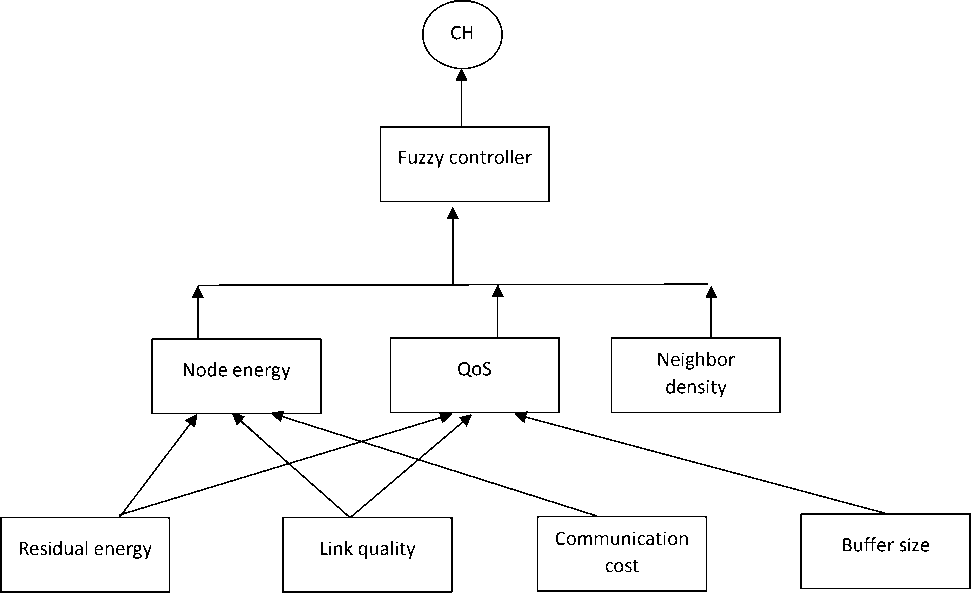
Fig.1. System architecture
In CH selection, the included parameters and their estimation method is mentioned below:
Fuzzy input values
Residual energy
The important resource is the energy in WSNs. While data aggregation, routing, and processing, the CHs consume more energy compared to the cluster members. Based on below expression, the residual energy is evaluated:
^ res ^ init ^ consumed
Where, Eint refers to the initial energy and Econsumed is the consumed energy of sensor nodes.
Link quality
When the receiver doesn’t receive the packets, the re-transmission method will occur that consumes additional energy at the sensor nodes. The desired energy efficiency achieves by considering the link quality to control the retransmission. The link quality estimates based on below equation:
LQ n =
RTn RTmin
RTmax - RTmin
Where, RTmin and RTmax refer to the minimum and maximum number of re-transmission from neighbor nodes respectively. The total re-transmission number between a node and the neighbors indicate by RTn.
Communication cost
Higher reliability of data delivery achieves by considering the communication cost. WSNs may include the occurrence of burst traffic due to the periodic broadcasting. The strong forwarders’ selection is essential for transmission to control the data loss. In two different ways, the communication cost can determine such as:
-
• Inter-cluster communication cost
-
• Intra-cluster communication cost
Buffer size
Different buffer sizes include in the nodes. Before their buffers are full, the collected data should send and some data will loss owing to the insufficient buffer of sensor node. By using the sensor node’s available average queue length, its buffer size estimates. The average queue length can compute based on the exponential weighted moving average:
BF avg = (1 W) * Q avg + W * Q sample
Where, Qayg refers to the queue size at the packet arrival, Q sample indicates the arrived amount of packets at t, and w represents the weight belongs to 0 < w < 1.
Fuzzy model
The best candidate selection is performed using fuzzy logic approach for CH role. The basic architecture of fuzzy system integrated with proposed method is shown below figure 2:

Fig.2. Fuzzy model
Four different building blocks contain in the fuzzy logic basic structure:
Fuzzifier: The system inputs are crisp set in the fuzzy based applications and they need to transform into fuzzy sets. Allocates the membership degree to each fuzzy set.
Fuzzy Rule Base: In this rule set, IF-THEN rules are included that decide with the help of a user. Using the rule base, the dynamic behavior of fuzzy system is defined.
Inference Engine: The fuzzy inference engine has tried to simulate the inference system based on IF-THEN rules and inputs.
Defuzzification: The fuzzy set mapping is obtained and is carried out from the inference engine into a crisp output value in the defuzzification. Some conclusion can draw using the output value.
Fuzzification
In this process, we use three variables. The minimum and maximum values of crisp input variable of fuzzifier for estimating the CH eligibility and they are utilized as shown below. By using node energy, the availability of total power is discussed at that instant time. Based on the consideration of CH candidature, node energy has described as the neighbouring nodes count in the surrounding node.
|
Input |
Variables |
|
Node energy |
low medium high |
|
Node QoS |
low medium high |
|
Neighbor density |
sparse medium dense |
Fuzzy rule base
The membership values have retrieved after fuzzification that is fed to the rule base under IF-THEN constraints. Based on the operators like OR and AND as inputs, a value is obtained. The aggregation method integrate all output values together and a maximum value is chosen from the aggregated fuzzy set. Using the Fuzzy Logic, the below fuzzy rules use for getting the eligibility index.
|
Rule |
Node Energy |
Node QoS |
Neighbor density |
Eligibility |
|
1 |
Low |
Low |
Dense |
Good |
|
2 |
Medium |
Low |
Dense |
Better |
|
3 |
High |
Low |
Dense |
Better |
|
4 |
Low |
Low |
Sparse |
Good |
|
5 |
Medium |
Medium |
Medium |
Better |
|
6 |
High |
Low |
Medium |
Good |
|
7 |
Low |
Low |
Medium |
Good |
|
8 |
Medium |
Low |
Medium |
Better |
|
9 |
High |
Low |
Sparse |
Better |
|
10 |
Low |
Medium |
Dense |
Good |
|
11 |
Medium |
Low |
Sparse |
Better |
|
12 |
High |
Medium |
Dense |
Far better |
|
13 |
Low |
Medium |
Sparse |
Better |
|
14 |
Medium |
Medium |
Dense |
Far better |
|
15 |
High |
Medium |
Medium |
Far better |
|
16 |
Low |
Medium |
Medium |
Good |
|
17 |
Medium |
Medium |
Sparse |
Far better |
|
18 |
High |
Medium |
Sparse |
Far better |
|
19 |
Low |
High |
Dense |
Good |
|
20 |
Medium |
High |
Dense |
Far better |
|
21 |
High |
High |
Dense |
Far better |
|
22 |
Low |
High |
Medium |
Good |
|
23 |
Medium |
High |
Medium |
Better |
|
24 |
High |
High |
Medium |
Far better |
|
25 |
Low |
High |
Sparse |
Good |
|
26 |
Medium |
High |
Sparse |
Far better |
|
27 |
High |
High |
Sparse |
Far better |
All nodes have compared based on the eligibility and the maximum chance of node is elected as the cluster-head. Each node integrates itself to the cluster-head in the cluster and the data is transmitted.
Data forwarding phase
Once the cluster is formed and accomplished the CH selection, the information is collected from its members for collision-free communication by using CH according to the allocated Time Division Multiple Access (TDMA) slot for each member. The CH is provided a TDMA slot to all its members while creating a cluster. After gathering the data from every node, it transmits to the BS using the TDMA schedule by each CH. One round completes by the proposed algorithm successfully along with the communication.
-
4. Result and Discussion
The proposed algorithm of multi-objective fuzzy clustering results have analysed in this section. Based on the optimization of cluster-head selection, energy efficiency achieves using the MOFL-MPR algorithm with integrated data aggregation. The appropriate CHs have chosen using multiple parameters and fuzzy logic in the proposed method which was implemented with NS2 simulator. In the simulation case, the network area considers as 1000*1000 m2 and number of nodes ranging from 50 to 250. The random scatter of sensor nodes over the network and initial energy as 100 joules has given to the nodes. CBR uses as traffic agent and the proposed technique evaluates based on throughput, overhead, packet delivery ratio, energy consumption, and end-to-end delay. In the below Table 1, the simulation parameters have shown. Here the proposed system compared with existing methods as EN-LEACH (Enhanced LEACH protocol) and EESRA.
-
5. Evaluation Results
Table 1. Network Parameters
|
Network area |
1000x1000m2 |
|
Network size |
50,100,150,200,250 |
|
Antenna type |
Omni antenna |
|
Initial energy |
100 joules |
|
Traffic type |
CBR |
|
Packet size |
1024 bytes |
|
Routing methods |
MOFL-MPR, EN-LEACH, EESRA |
Table 2. Analysis of Nodes vs delay
|
NODE |
PROPOSED |
EN-LEACH |
EESRA |
|
50 |
1.01 |
2.34 |
2.98 |
|
100 |
1.15 |
2.31 |
2.93 |
|
150 |
1.17 |
2.29 |
2.96 |
|
200 |
1.14 |
2.34 |
2.94 |
|
250 |
1.16 |
2.32 |
2.93 |
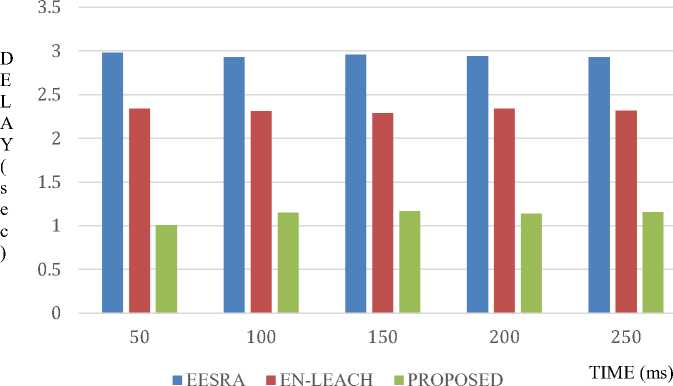
Fig.3. End to End Delay
The end-to-end delay time discusses for data transmission using above figure 3. In the network, the minimum delay was 1.01 ms and the maximum of 1.16ms delay were resulted if network size increases to 250 nodes. The minimum time delay achieves using the proposed technique with the parameters of communication cost, and link quality. For EESRA and EN-LEACH, the maximum time delays such as 2.93 and 2.32 ms have resulted respectively.
Table 3. Analysis of Nodes vs overhead
|
NODE |
PROPOSED |
EN-LEACH |
EESRA |
|
50 |
0.56 |
0.63 |
0.85 |
|
100 |
0.54 |
0.6 |
0.83 |
|
150 |
0.56 |
0.61 |
0.81 |
|
200 |
0.54 |
0.62 |
0.83 |
|
250 |
0.56 |
0.61 |
0.83 |
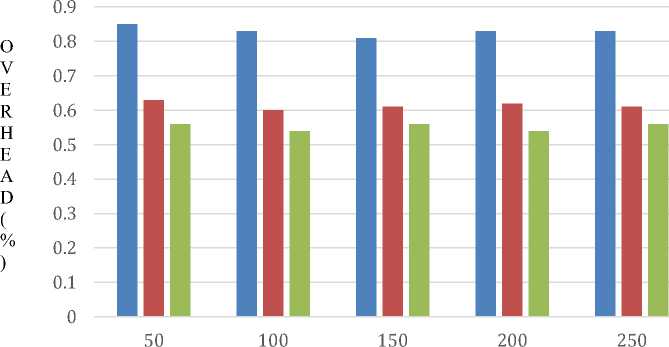
■ EESRA ■ EN-LEACH ■ PROPOSED TIME (ms)
Fig.4. Routing overhead
The overhead simulation results in a network are discussed in the above figure 4. For network operation, the overhead relevant to the amount of control packets transmit. In the proposed technique, 0.54% of overhead was observed whereas EESRA and EN-LEACH protocols result o.8 and o.6 respectively. The frequent broadcasting of control packets reduces with the multi-objective parameters such as node density and buffer size. Thus, the proposed technique maintains the lower overhead.
Table 4. Analysis of Nodes vs PDR
|
NODE |
PROPOSED |
EN-LEACH |
EESRA |
|
50 |
0.955 |
0.911 |
0.898 |
|
100 |
0.949 |
0.915 |
0.881 |
|
150 |
0.943 |
0.913 |
0.879 |
|
200 |
0.933 |
0.919 |
0.883 |
|
250 |
0.945 |
0.916 |
0.89 |
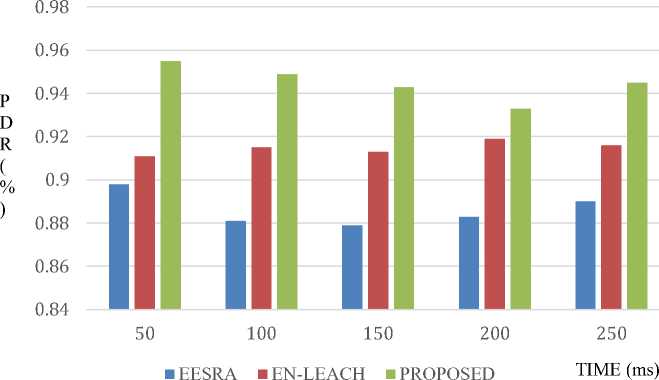
Fig.5. Packet delivery ratio
The packet delivery ratio simulation results have discussed in the above figure 5 for both existing and proposed techniques. The network quality for data transmission is defined as the PPDR. The maximum PDR of 0.955% is achieved using proposed technique. The PDR rates of 0.89 for EESRA and 0.91 for EN-LEACH have maintained. The proposed technique performance is better than the existing techniques based on different parameters like node quality, neighbor density, and link quality.
Table 5. Analysis of Nodes vs throughput
|
NODE |
PROPOSED |
EN-LEACH |
EESRA |
|
50 |
115 |
98 |
87 |
|
100 |
111 |
95 |
87 |
|
150 |
112 |
91 |
83 |
|
200 |
106 |
93 |
81 |
|
250 |
104 |
92 |
84 |
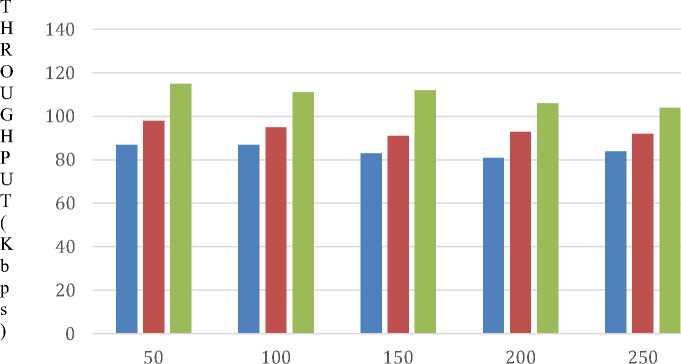
■ EESRA ■ EN-LEACH ■ PROPOSED TIME (ms)
Fig.6. Throughput
Throughput simulation results have shown in above diagram using both existing and proposed technique. It is defined as the amount of data to be transmitted between sensor nodes. The increased data delivery is ensured with higher throughput. When compared to the previous methods, the proposed technique results higher rate of throughput based on the analyzation of results. The throughput rate is maintained up to 115 using the proposed method while EESRA and EN-LEACH techniques have resulted 97 and 98 respectively.
E N E R G Y
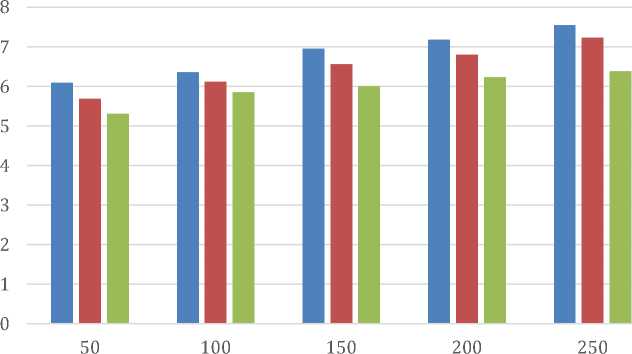
TIME (ms)
■ EESRA ■ EN-LEACH ■ PROPOSED
Table 6. Analysis of Nodes vs energy consumption
|
NODE |
PROPOSED |
EN-LEACH |
EESRA |
|
50 |
5.31 |
5.69 |
6.1 |
|
100 |
5.86 |
6.12 |
6.36 |
|
150 |
6.01 |
6.56 |
6.95 |
|
200 |
6.23 |
6.8 |
7.18 |
|
250 |
6.38 |
7.23 |
7.55 |
( j )
Fig.7. Energy consumption
The energy consumption rates for both proposed and previous methods have analyzed using simulation results. In this experiment, we consider the initial energy as 100 joules for all sensor nodes. Energy consumes for all activities in the network. The average energy of 5.9 joules was consumed whereas EESRA and EN-LEACH were consumed 6.8 and 6.4 joules respectively. Due to the node quality, communication cost, and residual energy parameters, the lower energy consumption achieves with the proposed method. Figure 7 represents the energy consumption.
-
6. Conclusion
A multi-objective fuzzy clustering algorithm (MOFL-MPR) is proposed in this paper that provides the features of distribution-independency and energy-efficiency for WSNs. Our proposed MOFL-MPR algorithm considers multiobjective parameters such as node energy, node QoS, and neighbour density parameters for CH selection by using the fuzzy logic to limit the occurred uncertainties for WSNs. The fuzzy logic system taking the fuzzy rules formulated based on different combinations of eligibility and measures the eligibility of the nodes to become CHs. The experiment includes fixed and mobile nodes in WSN. The sensor node mobility is due to the nodes’ location change without consuming the energy. The MOFL-MPR algorithm shows the better performance compared to the other existing methods based on the experimental evaluation.
For future work, intentional node movement, the change of location due to the intentional movement and energy consumption due to the movement can also be considered for reliability evaluation.
Список литературы A Multi-objective Fuzzy Logic based Multi-path Routing Algorithm for WSNs
- Khandare, A. and Alvi, A., 2018. Efficient clustering algorithm with enhanced cohesive quality clusters. International Journal of Intelligent Systems and Applications, 10(7), p.48.
- Shahraki, A., Taherkordi, A., Haugen, Ø. and Eliassen, F., 2020. A survey and future directions on clustering: From WSNs to IoT and modern networking paradigms. IEEE Transactions on Network and Service Management, 18(2), pp.2242-2274.
- Rostami, A.S., Badkoobe, M., Mohanna, F., Hosseinabadi, A.A.R. and Sangaiah, A.K., 2018. Survey on clustering in heterogeneous and homogeneous wireless sensor networks. The Journal of Supercomputing, 74(1), pp.277-323.
- Shokair, M. and Saad, W., 2017. Balanced and energy-efficient multi-hop techniques for routing in wireless sensor networks. IET Networks, 7(1), pp.33-43.
- Buvanesvari, R. and Begum, A.R., 2020. Energy-Efficient Unequal Clustering Algorithm Using Hybridization of Social Spider with Krill Herd in IoT-Assisted Wireless Sensor Networks. In Artificial Intelligence Techniques in IoT Sensor Networks (pp. 113-133). Chapman and Hall/CRC.
- Najjar-Ghabel, S., Farzinvash, L. and Razavi, S.N., 2020. Mobile sink-based data gathering in wireless sensor networks with obstacles using artificial intelligence algorithms. Ad Hoc Networks, 106, p.102243.
- Soro S, Heinzelman W (July 2009) Cluster head election techniques for coverage preservation in wireless sensor networks. Ad Hoc Netw 7(5):955–972.
- O. Younis, S. Fahmy, Distributed clustering in ad-hoc sensor networks: a hybrid, energy-efficient approach, IEEE Transactions on Mobile Computing 3 (4) (2004).
- Abdulqader M, Walid A, Khaled A, Abdulrahman A (2016) A robust harmony search algorithm based Markov model for node deployment in hybrid wireless sensor network. Int J Geomate 11(27):2747–2754.
- Dhawan H, Waraich S (2014) A comparative study on LEACH routing protocol and its variants in wireless sensor networks: a survey. Int J Comput Appl 95(8):975–8887.
- Barai LY, Gaikwad MA (2014) Performance evaluation of LEACH protocol for wireless sensor network. International Journal of Innovative Research in Advanced Engineering (IJIRAE) 1(6).
- Elsmany, E.F.A., Omar, M.A., Wan, T.C. and Altahir, A.A., 2019. EESRA: Energy efficient scalable routing algorithm for wireless sensor networks. IEEE Access, 7, pp.96974-96983.
- Abu Salem, A.O., Shudifat, N. Enhanced LEACH protocol for increasing a lifetime of WSNs. Pers Ubiquit Comput 23, 901–907 (2019). https://doi.org/10.1007/s00779-019-01205-4.
- Khan, K. and Goodridge, W., 2015. Fault Tolerant Multi-Criteria Multi-Path Routing in Wireless Sensor Networks. International Journal of Intelligent Systems and Applications, 7(6), p.55.
- Rezaeipanah, A., Nazari, H. and Abdollahi, M., 2020. Reducing energy consumption in wireless sensor networks using a routing protocol based on multi-level clustering and genetic algorithm. International Journal of Wireless and Microwave Technologies (IJWMT), 3(1), pp.1-16.
- Rajasekaran, K. and Balasubramanian, K., 2016. Energy conscious based multipath routing algorithm in WSN. International Journal of Computer Network and Information Security, 8(1), p.27.
- Saxena, S., Mishra, S. and Singh, M., 2013. Clustering based on node density in heterogeneous under-water sensor network. Int. J. Inf. Technol. Comput. Sci, 5(7), p.49.

